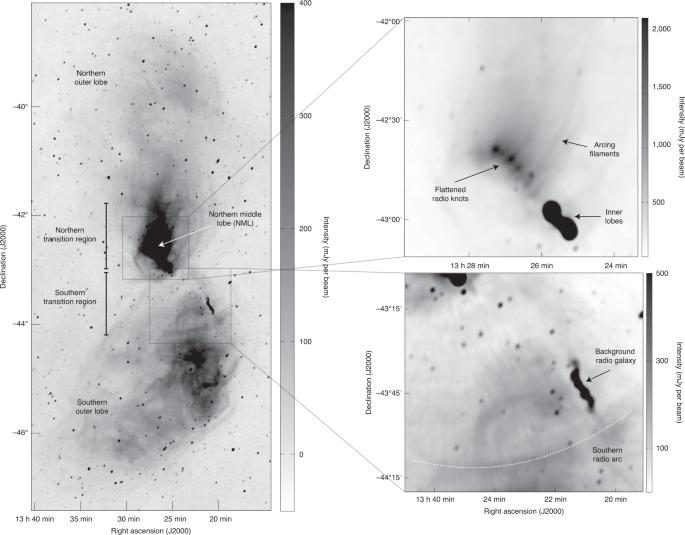Multi-scale feedback and feeding in the closest radio galaxy Centaurus A
King, A. & Pounds, K. Powerful outflows and feedback from active galactic nuclei. Annu. Rev. Astron. Astrophys. 53, 115–154 (2015).
Veilleux, S., Maiolino, R., Bolatto, A. & Aalto, S. Cool outflows in galaxies and their implications. Astron. Astrophys. Rev. 28, 2 (2020).
Nelson, D. et al. First results from the TNG50 simulation: galactic outflows driven by supernovae and black hole feedback. Mon. Not. R. Astron. Soc. 490, 3234–3261 (2019).
Heckman, T. et al. COS-burst: observations of the impact of starburst-driven winds on the properties of the circum-galactic medium. Astrophys. J. 846, 151 (2017).
Israel, F. P. & Centaurus, A.- Centaurus A–NGC 5128. Astron. Astrophys. Rev. 8, 237–278 (1998).
Feain, I. J. (ed.) The many faces of Centaurus A. Publ. Astron. Soc. Aust. 27(Special issue), 379-495 (2010).
Feain, I. J. et al. The radio continuum structure of Centaurus A at 1.4 GHz. Astrophys. J. 740, 17 (2011).
Neff, S. G., Eilek, J. A. & Owen, F. N. The complex north transition region of Centaurus A: radio structure. Astrophys. J. 802, 87 (2015).
Gaspari, M., Tombesi, F. & Cappi, M. Linking macro, meso, and micro scales in multiphase AGN feeding and feedback. Nat. Astron. 4, 10–13 (2020).
Gaspari, M., Ruszkowski, M. & Oh, S. P. Chaotic cold accretion on to black holes. Mon. Not. R. Astron. Soc. 432, 3401–3422 (2013).
Harris, G. L. H., Rejkuba, M. & Harris, W. E. The distance to NGC 5128 (Centaurus A). Publ. Astron. Soc. Aust. 27, 457–462 (2010).
Clarke, D. A., Burns, J. O. & Norman, M. L. VLA observations of the inner lobes of Centaurus A. Astrophys. J. 395, 444 (1992).
Tingay, S. J. et al. The subparsec-scale structure and evolution of Centaurus A: the nearest active radio galaxy. Astron. J. 115, 960–974 (1998).
Janssen, M. et al. Event Horizon Telescope observations of the jet launching and collimation in Centaurus A. Nat. Astron. 5, 1017–1028 (2021).
Tingay, S. J. et al. The Murchison Widefield Array: the Square Kilometre Array precursor at low radio frequencies. Publ. Astron. Soc. Aust. 30, 7 (2013).
Gaspari, M., Brighenti, F., D’Ercole, A. & Melioli, C. AGN feedback in galaxy groups: the delicate touch of self-regulated outflows. Mon. Not. R. Astron. Soc. 415, 1549–1568 (2011).
Gaspari, M. & Sądowski, A. Unifying the micro and macro properties of AGN feeding and feedback. Astrophys. J. 837, 149 (2017).
Krause, M. et al. A new connection between the jet opening angle and the large-scale morphology of extragalactic radio sources. Mon. Not. R. Astron. Soc. 427, 3196–3208 (2012).
Morganti, R., Killeen, N. E. B., Ekers, R. D. & Oosterloo, T. A. Centaurus A: multiple outbursts or bursting bubble? Mon. Not. R. Astron. Soc. 307, 750–760 (1999).
Kraft, R. P. et al. The jet heated X-ray filament in the Centaurus A northern middle radio lobe. Astrophys. J. 698, 2036–2047 (2009).
Neff, S. G., Eilek, J. A. & Owen, F. N. The complex north transition region of Centaurus A: a galactic wind. Astrophys. J. 802, 88 (2015).
Struve, C., Oosterloo, T. A., Morganti, R. & Saripalli, L. Centaurus A: morphology and kinematics of the atomic hydrogen. Astron. Astrophys. 515, 67 (2010).
Junkes, N., Haynes, R. F., Harnett, J. I. & Jauncey, D. L. Radio polarization surveys of Centaurus A (NGC 5128). I. The complete radio source at lambda 6.3 cm. Astron. Astrophys. 269, 29–38 (1993).
Cooper, J. L., Bicknell, G. V., Sutherland, R. S. & Bland-Hawthorn, J. Starburst-driven galactic winds: filament formation and emission processes. Astrophys. J. 703, 330–347 (2009).
Gronke, M. & Oh, S. P. The growth and entrainment of cold gas in a hot wind. Mon. Not. R. Astron. Soc. 480, 111–115 (2018).
Santoro, F. et al. The outer filament of Centaurus A as seen by MUSE. Astron. Astrophys. 575, 4 (2015).
Hamer, S. et al. MUSE discovers perpendicular arcs in the inner filament of Centaurus A. Astron. Astrophys. 575, 3 (2015).
Crockett, R. M. et al. Triggered star formation in the inner filament of Centaurus A. Mon. Not. R. Astron. Soc. 421, 1603–1623 (2012).
Crnojević, D. et al. The extended halo of Centaurus A: uncovering satellites, streams, and substructures. Astrophys. J. 823, 19 (2016).
Wang, J., Hammer, F., Rejkuba, M., Crnojević, D. & Yang, Y. A recent major merger tale for the closest giant elliptical galaxy Centaurus A. Mon. Not. R. Astron. Soc. 498, 2766–2777 (2020).
Bowman, J. D. et al. Science with the Murchison Widefield Array. Publ. Astron. Soc. Aust. 30, 31 (2013).
Turner, W. et al. Technical Report SKA-TEL-SKO-0000008, SKA Phase 1 System Requirements Specification (SKA Organisation, 2016).
Wayth, R. B. et al. The Phase II Murchison Widefield Array: design overview. Publ. Astron. Soc. Aust. 35, 33 (2018).
Beardsley, A. P. et al. Science with the Murchison Widefield Array: Phase I results and Phase II opportunities. Publ. Astron. Soc. Aust. 36, 50 (2019).
Offringa, A. R. et al. Post-correlation radio frequency interference classification methods. Mon. Not. R. Astron. Soc. 405, 155–167 (2010).
Offringa, A. R., van de Gronde, J. J. & Roerdink, J. B. T. M. A morphological algorithm for improving radio-frequency interference detection. Astron. Astrophys. 539, 95 (2012).
Offringa, A. R. et al. Parametrizing epoch of reionization foregrounds: a deep survey of low-frequency point-source spectra with the Murchison Widefield Array. Mon. Not. R. Astron. Soc. 458, 1057–1070 (2016).
Offringa, A. R. et al. WSCLEAN: an implementation of a fast, generic wide-field imager for radio astronomy. Mon. Not. R. Astron. Soc. 444, 606–619 (2014).
van der Tol, S., Veenboer, B. & Offringa, A. R. Image domain gridding: a fast method for convolutional resampling of visibilities. Astron. Astrophys. 616, 27 (2018).
Sokolowski, M. et al. Calibration and stokes imaging with full embedded element primary beam model for the Murchison Widefield Array. Publ. Astron. Soc. Aust. 34, 62 (2017).
McKinley, B. et al. The jet/wind outflow in Centaurus A: a local laboratory for AGN feedback. Mon. Not. R. Astron. Soc. 474, 4056–4072 (2018).
Anderson, C. et al. The extraordinary linear polarisation structure of the southern Centaurus A lobe revealed by ASKAP. Galaxies 6, 127 (2018).
Veilleux, S. et al. MMTF: The Maryland-Magellan Tunable Filter. Astron. J. 139, 145–157 (2010).
Magnier, E. A. & Cuillandre, J.-C. The Elixir system: data characterization and calibration at the Canada–France–Hawaii Telescope. Publ. Astron. Soc. Pac. 116, 449–464 (2004).
Gwyn, S. D. J. MegaPipe: the MegaCam image stacking pipeline at the Canadian Astronomical Data Centre. Publ. Astron. Soc. Pac. 120, 212 (2008).
Bertin, E. et al. The TERAPIX pipeline. In Astronomical Society of the Pacific Conference Proceedings, Astronomical Data Analysis Software and Systems XI Vol. 281 (eds Bohlender, D. A. et al.) 228–237 (Astronomical Society of the Pacific, 2002).
Bertin, E. & Arnouts, S. SExtractor: Software for source extraction. Astron. Astrophys. Suppl. 117, 393–404 (1996).
Turner, R. J. & Shabala, S. S. Energetics and lifetimes of local radio active galactic nuclei. Astrophys. J. 806, 59 (2015).
Eisenreich, M., Naab, T., Choi, E., Ostriker, J. P. & Emsellem, E. Active galactic nuclei feedback, quiescence and circumgalactic medium metal enrichment in early-type galaxies. Mon. Not. R. Astron. Soc. 468, 751–768 (2017).
Yoon, D. et al. Active galactic nucleus feedback in an elliptical galaxy with the most updated AGN physics. II. High angular momentum case. Astrophys. J. 864, 6 (2018).
Li, Y.-P. et al. Stellar and AGN feedback in isolated early-type galaxies: the role in regulating star formation and ISM properties. Astrophys. J. 866, 70 (2018).
Su, K.-Y. et al. Which AGN jets quench star formation in massive galaxies? Mon. Not. R. Astron. Soc. 507, 175–204 (2021).
Bondi, H. On spherically symmetrical accretion. Mon. Not. R. Astron. Soc. 112, 195–204 (1952).
Gaspari, M. et al. The X-ray halo scaling relations of supermassive black holes. Astrophys. J. 884, 169 (2019).
Best, P. N. & Heckman, T. On the fundamental dichotomy in the local radio-AGN population: accretion, evolution and host galaxy properties. Mon. Not. R. Astron. Soc. 421, 1569–1582 (2012).
Hardcastle, M. Interpreting radiative efficiency in radio-loud AGNs. Nat. Astron. 2, 273–274 (2018).
Gaspari, M. The self-regulated AGN feedback loop: the role of chaotic cold accretion. Proc. Int. Astron. Union 11, 17–20 (2016).
Gaspari, M. Shaken snow globes: kinematic tracers of the multiphase condensation cascade in massive galaxies, groups, and clusters. Astrophys. J. 854, 167 (2018).
Gaspari, M., Temi, P. & Brighenti, F. Raining on black holes and massive galaxies: the top-down multiphase condensation model. Mon. Not. R. Astron. Soc. 466, 677–704 (2017).
Gaspari, M. Shaping the X-ray spectrum of galaxy clusters with AGN feedback and turbulence. Mon. Not. R. Astron. Soc. 451, 60–64 (2015).
Gaspari, M., Melioli, C., Brighenti, F. & D’Ercole, A. The dance of heating and cooling in galaxy clusters: three-dimensional simulations of self-regulated active galactic nuclei outflows. Mon. Not. R. Astron. Soc. 411, 349–372 (2011).
Kraft, R. P. et al. X-ray emission from the hot interstellar medium and southwest radio lobe of the nearby radio galaxy Centaurus A. Astrophys. J. 592, 129–146 (2003).
Heywood, I. et al. Inflation of 430-parsec bipolar radio bubbles in the Galactic Centre by an energetic event. Nature 573, 235–237 (2019).
Su, M., Slatyer, T. R. & Finkbeiner, D. P. Giant gamma-ray bubbles from Fermi-LAT: active galactic nucleus activity or bipolar galactic wind? Astron. J. 724, 1044–1082 (2010).
Dobler, G. et al. The Fermi haze: A gamma-ray counterpart to the microwave haze. Astron. J. 717, 825–842 (2010).
Carretti, E. et al. Giant magnetized outflows from the centre of the Milky Way. Nature 493, 66–69 (2013).
Finkbeiner, D. P. Microwave interstellar medium emission observed by the Wilkinson Microwave Anisotropy Probe. Astrophys. J. 614, 186–193 (2004).
Crocker, R. M., Bicknell, G. V., Taylor, A. M. & Carretti, E. A unified model of the Fermi bubbles, microwave haze, and polarized radio lobes: reverse shocks in the Galactic Center’s giant outflows. Astrophys. J. 808, 107 (2015).
Merloni, A., Nandra, K. & Predehl, P. eROSITAa’s X-ray eyes on the Universe. Nat. Astron. 4, 634–636 (2020).
Predehl, P. et al. Detection of large-scale X-ray bubbles in the Milky Way halo. Nature 588, 227–231 (2020).
Bogdán, Á. & Gilfanov, M. Soft band X/K luminosity ratios for gas-poor early-type galaxies. Astron. Astrophys. 512, 16 (2010).
Sądowski, A. & Gaspari, M. Kinetic and radiative power from optically thin accretion flows. Mon. Not. R. Astron. Soc. 468, 1398–1404 (2017).
Gaspari, M., Brighenti, F. & Temi, P. Mechanical AGN feedback: controlling the thermodynamical evolution of elliptical galaxies. Mon. Not. R. Astron. Soc. 424, 190–209 (2012).
Godfrey, L. E. H. & Shabala, S. S. Mutual distance dependence drives the observed jet-power–radio-luminosity scaling relations in radio galaxies. Mon. Not. R. Astron. Soc. 456, 1172–1184 (2016).
Eilek, J. A. The dynamic age of Centaurus A. New J. Phys. 16, 045001 (2014).
Wykes, S. et al. Mass entrainment and turbulence-driven acceleration of ultra-high energy cosmic rays in Centaurus A. Astron. Astrophys. 558, 19 (2013).
O’Sullivan, S. P. et al. Thermal plasma in the giant lobes of the radio galaxy Centaurus A. Astrophys. J. 764, 162 (2013).
Stawarz, Ł. et al. Giant lobes of Centaurus A radio galaxy observed with the Suzaku X-ray satellite. Astrophys. J. 766, 48 (2013).
Schiminovich, D., van Gorkom, J. H., van der Hulst, J. M. & Kasow, S. Discovery of neutral hydrogen associated with the diffuse shells of NGC 5128 (Centaurus A). Astrophys. J. Lett. 423, 101 (1994).
Graham, J. A. & Price, R. M. The gaseous filaments in the northeast halo region of NGC 5128 (Centaurus A). Astrophys. J. 247, 813–822 (1981).
Morganti, R. et al. The nature of the optical filaments in Centaurus A. Evidence for a beamed ionizing continuum. Mon. Not. R. Astron. Soc. 249, 91–112 (1991).
Santoro, F. et al. The jet-ISM interaction in the outer filament of Centaurus A. Astron. Astrophys. 574, 89 (2015).
Sutherland, R. S., Bicknell, G. V. & Dopita, M. A. Shock excitation of the emission-line filaments in Centaurus A. Astrophys. J. 414, 510 (1993).
Gaspari, M., Ruszkowski, M. & Sharma, P. Cause and effect of feedback: multiphase gas in cluster cores heated by AGN jets. Astrophys. J. 746, 94 (2012).
Kraft, R. P. et al. Evidence for nonhydrostatic gas motions in the hot interstellar medium of Centaurus A. Astrophys. J. 677, 97 (2008).
Król, D. Ł., Marchenko, V., Ostrowski, M. & Stawarz, Ł. An analysis of soft X-ray structures at kiloparsec distances from the active nucleus of Centaurus A galaxy. Astrophys. J. 903, 107 (2020).
Israel, F. P. et al. The outflow of gas from the Centaurus A circumnuclear disk. Atomic spectral line maps from Herschel/PACS and APEX. Astron. Astrophys. 599, 53 (2017).
Veilleux, S., Cecil, G. & Bland-Hawthorn, J. Galactic winds. Annu. Rev. Astron. Astrophys. 43, 769–826 (2005).
DeBoer, D. R. et al. Australian SKA Pathfinder: a high-dynamic range wide-field of view survey telescope. Proc. IEEE 97, 1507–1521 (2009).
Hotan, A. W. et al. The Australian Square Kilometre Array Pathfinder: system architecture and specifications of the Boolardy engineering test array. Publ. Astron. Soc. Aust. 31, 41 (2014).
Camilo, F. et al. Revival of the magnetar PSR J1622-4950: observations with MeerKAT, Parkes, XMM-Newton, Swift, Chandra, and NuSTAR. Astron. J. 856, 180 (2018).
Jonas, J. et al. The MeerKAT radio telescope. In Proc. of MeerKAT Science: On the Pathway to the SKA Proceedings of Science, Vol. 277 (eds Taylor, R. et al.) Article ID 001 (SISSA, 2018).
Tingay, S. J., Preston, R. A. & Jauncey, D. L. The subparsec-scale structure and evolution of Centaurus A. II. Continued very long baseline array monitoring. Astron. J. 122, 1697–1706 (2001).
Jones, D. L. et al. Discovery of a sub-parsec radio counterjet in the nucleus of Centaurus A. Astrophys. J. 466, 63 (1996).
Tombesi, F. et al. Ultrafast outflows in radio-loud active galactic nuclei. Mon. Not. R. Astron. Soc. 443, 2154–2182 (2014).
Nesvadba, N. P. H. et al. Gas kinematics in powerful radio galaxies at z ~ 2: energy supply from star formation, AGN, and radio jets. Astron. Astrophys. 600, 121 (2017).
Morganti, R. Radio jets clearing the way through galaxies: the view from HI and molecular gas. Proc. Int. Astron. Union 313, 283–288 (2015).
Bicknell, G. V. et al. AGN feedback by relativistic jets. Proc. Int. Astron Union 313, 101–107 (2015).
van Gorkom, J. H. et al. H i absorption in radio elliptical galaxies—evidence for infall. Astron. J. 97, 708–719 (1989).
van der Hulst, J. M. et al. The H i absorption in NGC 5128 (Centaurus A). Astrophys. J. 264, 37–41 (1983).
Best, P. N. The host galaxies of radio-loud active galactic nuclei: mass dependences, gas cooling and active galactic nuclei feedback. Mon. Not. R. Astron. Soc. 362, 25–40 (2005).
Neumayer, N. The supermassive black hole at the heart of Centaurus A: revealed by the kinematics of gas and stars. Publ. Astron. Soc. Aust. 27, 449–456 (2010).
Cooper, B. F. C., Price, R. M. & Cole, D. J. A study of the decimetric emission and polarization of Centaurus A. Aust. J. Phys. 18, 589–626 (1965).
McNamara, B. R. et al. An energetic AGN outburst powered by a rapidly spinning supermassive black hole or an accreting ultramassive black hole. Astrophys. J. 698, 594–605 (2009).
McDonald, M. et al. Observational evidence for enhanced black hole accretion in giant elliptical galaxies. Astrophys. J. 908, 85 (2021).
Donnari, M. et al. The star formation activity of IllustrisTNG galaxies: main sequence, UVJ diagram, quenched fractions, and systematics. Mon. Not. R. Astron. Soc. 485, 4817–4840 (2019).
Zinger, E. et al. Ejective and preventative: the IllustrisTNG black hole feedback and its effects on the thermodynamics of the gas within and around galaxies. Mon. Not. R. Astron. Soc. 499, 768–792 (2020).
Bassini, L. et al. Black hole mass of central galaxies and cluster mass correlation in cosmological hydro-dynamical simulations. Astron. Astrophys. 630, 144 (2019).
Truong, N., Pillepich, A. & Werner, N. Correlations between supermassive black holes and hot gas atmospheres in IllustrisTNG and X-ray observations. Mon. Not. R. Astron. Soc. 501, 2210–2230 (2021).
Mitchell, P. D. et al. Galactic outflow rates in the EAGLE simulations. Mon. Not. R. Astron. Soc. 494, 3971–3997 (2020).
Davé, R. et al. SIMBA: cosmological simulations with black hole growth and feedback. Mon. Not. R. Astron. Soc. 486, 2827–2849 (2019).
Beckmann, R. S. et al. Cosmic evolution of stellar quenching by AGN feedback: clues from the Horizon-AGN simulation. Mon. Not. R. Astron. Soc. 472, 949–965 (2017).
Tremmel, M. et al. Introducing ROMULUSC: a cosmological simulation of a galaxy cluster with an unprecedented resolution. Mon. Not. R. Astron. Soc. 483, 3336–3362 (2019).
Marinacci, F. et al. First results from the IllustrisTNG simulations: radio haloes and magnetic fields. Mon. Not. R. Astron. Soc. 480, 5113–5139 (2018).
Naiman, J. P. et al. First results from the IllustrisTNG simulations: a tale of two elements—chemical evolution of magnesium and europium. Mon. Not. R. Astron. Soc. 477, 1206–1224 (2018).
Nelson, D. et al. First results from the IllustrisTNG simulations: the galaxy colour bimodality. Mon. Not. R. Astron. Soc. 475, 624–647 (2018).
Pillepich, A. et al. First results from the IllustrisTNG simulations: the stellar mass content of groups and clusters of galaxies. Mon. Not. R. Astron. Soc. 475, 648–675 (2018).
Springel, V. et al. First results from the IllustrisTNG simulations: matter and galaxy clustering. Mon. Not. R. Astron. Soc. 475, 676–698 (2018).
Pillepich, A. et al. First results from the TNG50 simulation: the evolution of stellar and gaseous discs across cosmic time. Mon. Not. R. Astron. Soc. 490, 3196–3233 (2019).
Brennan, R. et al. Momentum-driven winds from radiatively efficient black hole accretion and their impact on galaxies. Astrophys. J. 860, 14 (2018).
Gofford, J. et al. The Suzaku view of highly ionized outflows in AGN—I. Statistical detection and global absorber properties. Mon. Not. R. Astron. Soc. 430, 60–80 (2013).
Gofford, J. et al. The Suzaku view of highly ionized outflows in AGN—II. Location, energetics and scalings with bolometric luminosity. Mon. Not. R. Astron. Soc. 451, 4169–4182 (2015).
Tombesi, F. et al. Feeding and feedback in the powerful radio galaxy 3C 120. Astrophys. J. 838, 16 (2017).
Harrison, C. M. et al. The KMOS AGN survey at high redshift (KASHz): the prevalence and drivers of ionized outflows in the host galaxies of X-ray AGN. Mon. Not. R. Astron. Soc. 456, 1195–1220 (2016).
Schmidt, M., Schneider, D. P. & Gunn, J. E. Spectroscopic CCD surveys for quasars at large redshift IV: evolution of the luminosity function from quasars detected by their Lyman-alpha emission. Astron. J. 110, 68–77 (1995).
Leung, G. C. K. et al. The MOSDEF survey: the prevalence and properties of galaxy-wide AGN-driven outflows at z ~ 2. Astrophys. J. 849, 48 (2017).
Circosta, C. et al. SUPER I: toward an unbiased study of ionized outflows in z ~ 2 active galactic nuclei: survey overview and sample characterization. Astron. Astrophys. 620, 82 (2018).
Kakkad, D. et al. SUPER II: spatially resolved ionised gas kinematics and scaling relations in z ~ 2 AGN host galaxies. Astron. Astrophys. 642, 147 (2020).
Bischetti, M. et al. Widespread QSO-driven outflows in the early Universe. Astron. Astrophys. 630, 59 (2019).
Croston, J. H. et al. High-energy particle acceleration at the radio-lobe shock of Centaurus A. Mon. Not. R. Astron. Soc. 395, 1999–2012 (2009).
Keel, W. C. et al. Optical detection of star formation in a cold dust cloud in the counterjet direction of Centaurus A. Astron. J. 157, 66 (2019).
O’Sullivan, E., Ponman, T. J. & Collins, R. S. X-ray scaling properties of early-type galaxies. Mon. Not. R. Astron. Soc. 340, 1375–1399 (2003).
Try Adsterra Earnings, it’s 100% Authentic to make money more and more.

More Story on Source:
*here*
Multi-scale feedback and feeding in the closest radio galaxy Centaurus A
Published By

Latest entries
 allPost2025.02.01Small plane crashes near mall in Philadelphia
allPost2025.02.01Small plane crashes near mall in Philadelphia allPost2025.02.01Trump administration escalates showdown with local authorities over enforcement
allPost2025.02.01Trump administration escalates showdown with local authorities over enforcement allPost2025.02.01More victims recovered after deadly midair collision
allPost2025.02.01More victims recovered after deadly midair collision allPost2025.02.01CDC website scrubs HIV content following Trump diversity policy changes
allPost2025.02.01CDC website scrubs HIV content following Trump diversity policy changes




